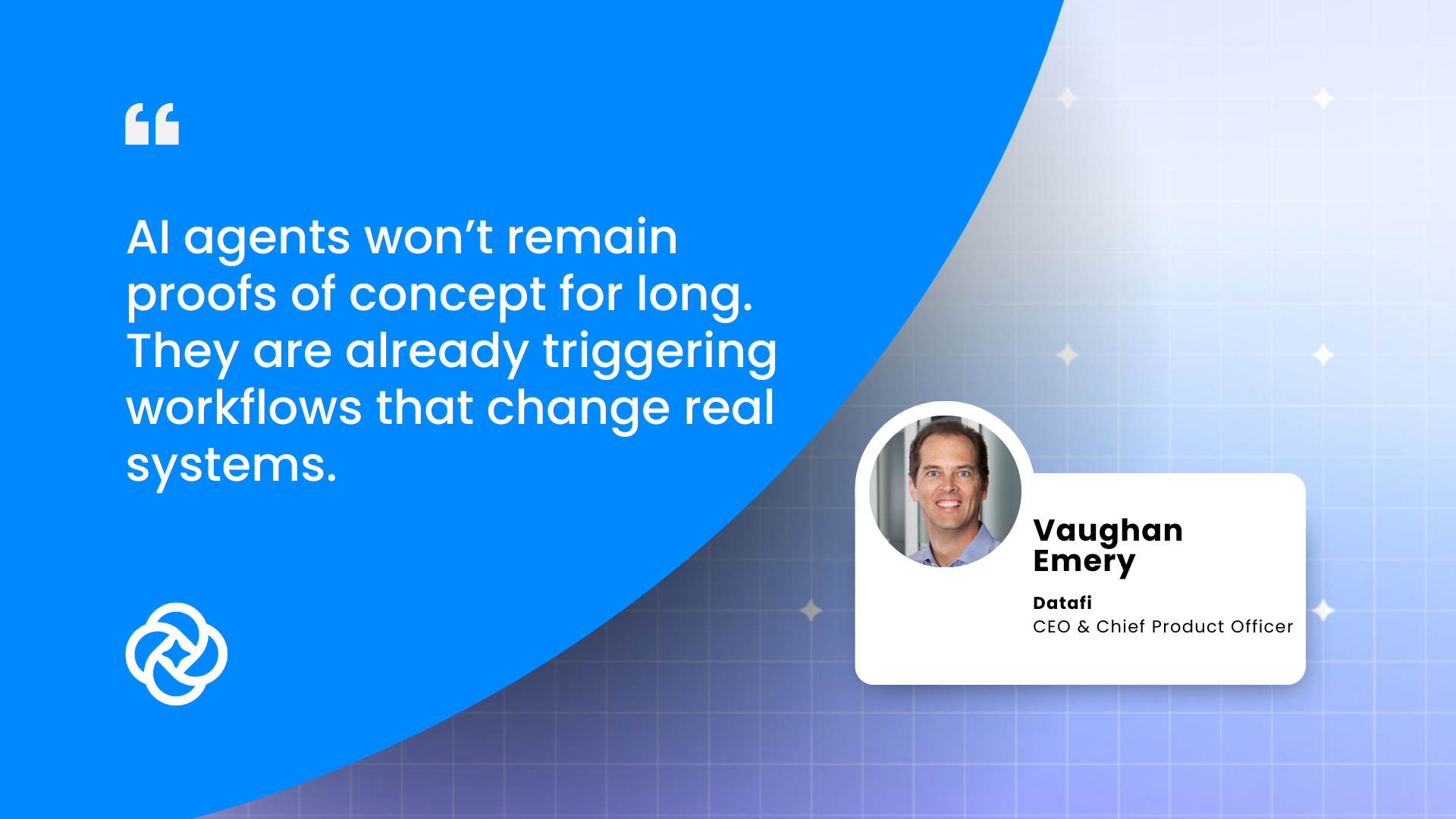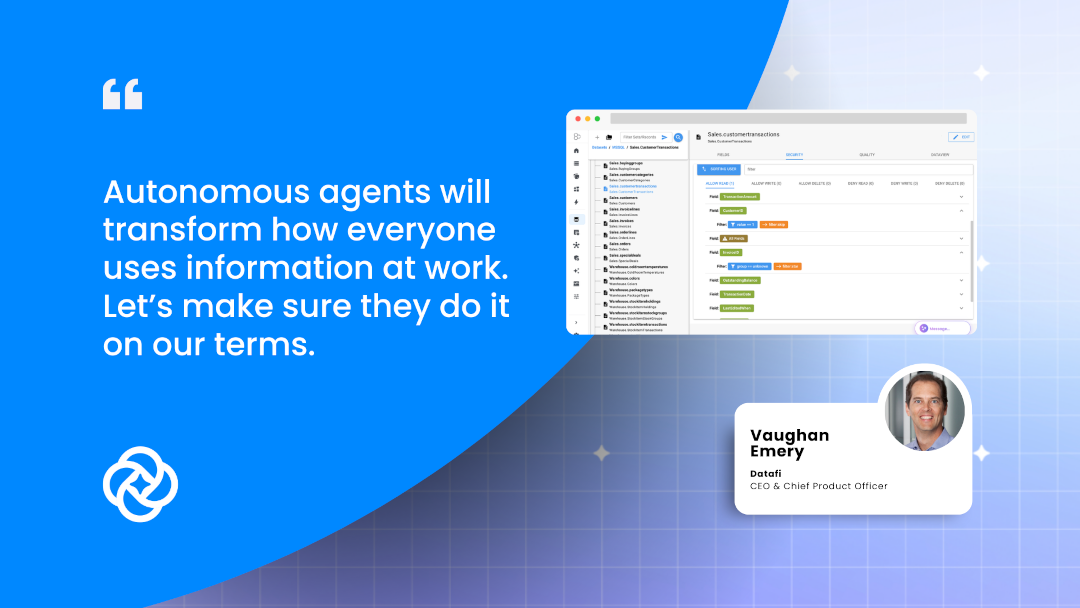Why Datafi Embraces Attribute-Based Access Control (ABAC) for Security

Understanding ABAC vs. Traditional Access Control
Attribute-Based Access Control (ABAC) is an authorization model that grants access according to attributes tied to users, data, actions, and context rather than to fixed roles or lists. For example, if Sam's employee ID is 12345, Datafi can authorize access based on that ID, not on Sam's job title.
Older models—Mandatory Access Control (MAC), Discretionary Access Control (DAC), and Role-Based Access Control (RBAC)—assign static, user-centric permissions. RBAC, for instance, grants rights by role or job title and disregards context, such as what data is requested, why, or under what conditions. Consequently, traditional approaches may overlook nuances (time-based rules, data-sensitivity levels) and give users overly broad access.
ABAC closes these gaps by evaluating multiple attributes at decision time. Typical attributes include:
- User: Department, clearance level, job role
- Resource: Classification, owner, content type
- Action: Read, write, delete
- Context: Time of day, location, device
A sample ABAC policy might be
Allow access if the user. Department = 'Finance'AND data.classification = ‘Financial’ AND current_time falls within business hours.
Such logic applies automatically to any user and dataset matching the attributes—no predefined role is required.
Why ABAC Is a Game-Changer
- Eliminates Role Overload: Reduces excessive role creation by relying on attributes.
- Enforces Real-Time Security: Updates permissions instantly as user status, location, or device security change.
- Manages Complex Rules: Enables fine-grained conditions (time of day, device type, data classification).
- Scalable and Future-Ready: Works consistently across APIs, databases, and cloud environments.
- Persistent Security Model: Decouples control from source systems; rules are enforced solely on user and data attributes.
ABAC balances security with accessibility, protecting data while ensuring people get the correct information under the right conditions.
Access Control and Identity Management in Datafi
Datafi enforces granular ABAC policies so each user sees only authorized data. Queries for disallowed datasets return no results, preventing accidental exposure. Datafi integrates with enterprise identity providers such as Okta, Azure AD, and Active Directory to strengthen authentication, supporting third-party single sign-on (SSO) and federated authentication. This lets organizations apply corporate login policies, including multi-factor authentication, and manage centralized provisioning or deactivation. Datafi also retains audit logs (length depends on the plan) to track who accessed what data and when aiding governance and forensic analysis.
Industry Examples of ABAC in Action
Datafi is not alone in leveraging ABAC for security; many forward-thinking companies and platforms use ABAC or similar attribute-driven models to protect data. Here are a few notable examples and comparisons:
- Major Cloud Providers (AWS): Cloud computing platforms have embraced ABAC to manage complex access scenarios at scale. Amazon Web Services, for instance, allows administrators to define access policies based on attributes called tags. AWS Identity and Access Management (IAM) can dynamically use tags (attributes attached to users and resources) to grant permissions. This is AWS's form of ABAC (define permissions based on attributes with ABAC authorization). For example, an AWS policy might allow a developer to start or stop any cloud server if the server's "project" tag matches the developer's project attribute. This approach has been championed for its flexibility in large cloud environments where creating separate roles for every project or team becomes unwieldy. AWS documentation explicitly describes ABAC as a strategy for fine-grained permissions based on user attributes like department, job role, and resource characteristics (Attribute-Based Access Control (ABAC) for AWS). The adoption of ABAC by a leading provider like AWS highlights how critical it is for scaling secure access in complex IT landscapes.
- Data Governance and Analytics Platforms (Immuta, Okera, etc.): Several platforms have built their security model around ABAC in the big data and analytics domain. Immuta is a prominent example: it provides a data access control solution that uses ABAC policies to restrict data at the row, column, or cell level based on attributes (like a user's clearance or purpose of use). Industry experts note that Immuta's approach is more dynamic than traditional Apache Ranger (an older RBAC-based system)—Immuta's ABAC model allows for more nuanced, on-the-fly policies, whereas Ranger relied heavily on static roles (Security and Privacy in the Modern Data World—Seattle Data Guy). This dynamic nature has proven valuable for companies that must enforce privacy regulations (like GDPR or HIPAA) because policies can incorporate regulatory rules as attributes (e.g., data usage purpose, user consent status) and automatically ensure compliance. Microsoft's cloud experts pointed to Immuta (and a similar tool, Okera) as a go-to solution for ABAC, given that Azure's native tools had limited ABAC support until recently (Data Platform products for Microsoft gaps | James Serra's Blog). Immuta and Okera integrate with modern data platforms (Snowflake, Databricks, BigQuery, etc.) to provide fine-grained authorization, underscoring the industry trend toward attribute-driven security for sensitive data.
- Data Catalog and Governance Tools (Collibra, Alation):Enterprise data catalog software in the same ecosystem as Datafi also recognizes the need for attribute-based controls. Many catalogs support tagging data with classifications and have begun to support ABAC or policy-based access. For example, Collibra users can integrate with solutions like SecuPi to enforce attribute-based policies on data discovered in the catalog (Attribute-Based Access Control for Collibra & Analytics Applications) (Collibra primarily manages metadata and delegates enforcement to such policy engines). Alation, another catalog, can partner with tools like Immuta or Privacera to implement ABAC on its catalog datasets (How Does a Data Catalog Support Data Fabric? - Alation). Even within the catalogs, one often finds both RBAC and ABAC features: one industry glossary notes that a robust data catalog "supports RBAC and ABAC" for restricting access to sensitive data (Understanding Data Catalogs: Features, Comparisons, and Use Cases). This means that simply discovering data in a catalog isn't enough—attribute-based rules determine if a user browsing the catalog can preview or query a dataset. Datafi's use of ABAC aligns well with these industry practices since Datafi also functions as a unified catalog and access layer.
- Enterprise and Government Use: Large enterprises and government agencies have pioneered ABAC adoption. In government, ABAC gained traction as a way to securely share information across departments without hard-coding roles for every collaboration. Every branch of the United States military has started using ABAC in some form, and the U.S. Department of Commerce mandated ABAC as a practice for its units (Attribute-based access control—Wikipedia). This mandate spreads to other agencies because ABAC provides a more data-centric, condition-based security that fits zero-trust philosophies. Outside of government, tech giants also utilize ABAC concepts. For example, Google's internal BeyondCorp security model (often cited in the context of zero trust) essentially treats user and device attributes as the basis for access to corporate resources—a real-world ABAC application. Similarly, many financial institutions use ABAC to meet the principle of least privilege, ensuring traders or analysts only access data for clients or accounts authorized by encoding those constraints as attributes rather than maintaining thousands of bespoke roles.
These examples illustrate that ABAC is not an experimental niche approach but a proven model used by leading organizations to enhance security. Datafi's use of ABAC aligns with best practices in cloud infrastructure and advanced data governance systems. It also distinguishes Datafi from older data platforms that rely purely on roles or manual permissions. Using ABAC, Datafi shares a philosophy with companies known for rigorous security, flexibility and precision in access control.
Why Datafi Embraces Attribute-Based Access Control (ABAC) for Security
Understanding ABAC vs. Traditional Access Control
Attribute-Based Access Control (ABAC) is an authorization model that grants access according to attributes tied to users, data, actions, and context rather than to fixed roles or lists. For example, if Sam's employee ID is 12345, Datafi can authorize access based on that ID, not on Sam's job title.
Older models—Mandatory Access Control (MAC), Discretionary Access Control (DAC), and Role-Based Access Control (RBAC)—assign static, user-centric permissions. RBAC, for instance, grants rights by role or job title and disregards context, such as what data is requested, why, or under what conditions. Consequently, traditional approaches may overlook nuances (time-based rules, data-sensitivity levels) and give users overly broad access.
ABAC closes these gaps by evaluating multiple attributes at decision time. Typical attributes include:
- User: Department, clearance level, job role
- Resource: Classification, owner, content type
- Action: Read, write, delete
- Context: Time of day, location, device
A sample ABAC policy might be
Allow access if the user. Department = 'Finance'AND data.classification = ‘Financial’ AND current_time falls within business hours.
Such logic applies automatically to any user and dataset matching the attributes—no predefined role is required.
Why ABAC Is a Game-Changer
- Eliminates Role Overload: Reduces excessive role creation by relying on attributes.
- Enforces Real-Time Security: Updates permissions instantly as user status, location, or device security change.
- Manages Complex Rules: Enables fine-grained conditions (time of day, device type, data classification).
- Scalable and Future-Ready: Works consistently across APIs, databases, and cloud environments.
- Persistent Security Model: Decouples control from source systems; rules are enforced solely on user and data attributes.
ABAC balances security with accessibility, protecting data while ensuring people get the correct information under the right conditions.
Access Control and Identity Management in Datafi
Datafi enforces granular ABAC policies so each user sees only authorized data. Queries for disallowed datasets return no results, preventing accidental exposure. Datafi integrates with enterprise identity providers such as Okta, Azure AD, and Active Directory to strengthen authentication, supporting third-party single sign-on (SSO) and federated authentication. This lets organizations apply corporate login policies, including multi-factor authentication, and manage centralized provisioning or deactivation. Datafi also retains audit logs (length depends on the plan) to track who accessed what data and when aiding governance and forensic analysis.
Industry Examples of ABAC in Action
Datafi is not alone in leveraging ABAC for security; many forward-thinking companies and platforms use ABAC or similar attribute-driven models to protect data. Here are a few notable examples and comparisons:
- Major Cloud Providers (AWS): Cloud computing platforms have embraced ABAC to manage complex access scenarios at scale. Amazon Web Services, for instance, allows administrators to define access policies based on attributes called tags. AWS Identity and Access Management (IAM) can dynamically use tags (attributes attached to users and resources) to grant permissions. This is AWS's form of ABAC (define permissions based on attributes with ABAC authorization). For example, an AWS policy might allow a developer to start or stop any cloud server if the server's "project" tag matches the developer's project attribute. This approach has been championed for its flexibility in large cloud environments where creating separate roles for every project or team becomes unwieldy. AWS documentation explicitly describes ABAC as a strategy for fine-grained permissions based on user attributes like department, job role, and resource characteristics (Attribute-Based Access Control (ABAC) for AWS). The adoption of ABAC by a leading provider like AWS highlights how critical it is for scaling secure access in complex IT landscapes.
- Data Governance and Analytics Platforms (Immuta, Okera, etc.): Several platforms have built their security model around ABAC in the big data and analytics domain. Immuta is a prominent example: it provides a data access control solution that uses ABAC policies to restrict data at the row, column, or cell level based on attributes (like a user's clearance or purpose of use). Industry experts note that Immuta's approach is more dynamic than traditional Apache Ranger (an older RBAC-based system)—Immuta's ABAC model allows for more nuanced, on-the-fly policies, whereas Ranger relied heavily on static roles (Security and Privacy in the Modern Data World—Seattle Data Guy). This dynamic nature has proven valuable for companies that must enforce privacy regulations (like GDPR or HIPAA) because policies can incorporate regulatory rules as attributes (e.g., data usage purpose, user consent status) and automatically ensure compliance. Microsoft's cloud experts pointed to Immuta (and a similar tool, Okera) as a go-to solution for ABAC, given that Azure's native tools had limited ABAC support until recently (Data Platform products for Microsoft gaps | James Serra's Blog). Immuta and Okera integrate with modern data platforms (Snowflake, Databricks, BigQuery, etc.) to provide fine-grained authorization, underscoring the industry trend toward attribute-driven security for sensitive data.
- Data Catalog and Governance Tools (Collibra, Alation):Enterprise data catalog software in the same ecosystem as Datafi also recognizes the need for attribute-based controls. Many catalogs support tagging data with classifications and have begun to support ABAC or policy-based access. For example, Collibra users can integrate with solutions like SecuPi to enforce attribute-based policies on data discovered in the catalog (Attribute-Based Access Control for Collibra & Analytics Applications) (Collibra primarily manages metadata and delegates enforcement to such policy engines). Alation, another catalog, can partner with tools like Immuta or Privacera to implement ABAC on its catalog datasets (How Does a Data Catalog Support Data Fabric? - Alation). Even within the catalogs, one often finds both RBAC and ABAC features: one industry glossary notes that a robust data catalog "supports RBAC and ABAC" for restricting access to sensitive data (Understanding Data Catalogs: Features, Comparisons, and Use Cases). This means that simply discovering data in a catalog isn't enough—attribute-based rules determine if a user browsing the catalog can preview or query a dataset. Datafi's use of ABAC aligns well with these industry practices since Datafi also functions as a unified catalog and access layer.
- Enterprise and Government Use: Large enterprises and government agencies have pioneered ABAC adoption. In government, ABAC gained traction as a way to securely share information across departments without hard-coding roles for every collaboration. Every branch of the United States military has started using ABAC in some form, and the U.S. Department of Commerce mandated ABAC as a practice for its units (Attribute-based access control—Wikipedia). This mandate spreads to other agencies because ABAC provides a more data-centric, condition-based security that fits zero-trust philosophies. Outside of government, tech giants also utilize ABAC concepts. For example, Google's internal BeyondCorp security model (often cited in the context of zero trust) essentially treats user and device attributes as the basis for access to corporate resources—a real-world ABAC application. Similarly, many financial institutions use ABAC to meet the principle of least privilege, ensuring traders or analysts only access data for clients or accounts authorized by encoding those constraints as attributes rather than maintaining thousands of bespoke roles.
These examples illustrate that ABAC is not an experimental niche approach but a proven model used by leading organizations to enhance security. Datafi's use of ABAC aligns with best practices in cloud infrastructure and advanced data governance systems. It also distinguishes Datafi from older data platforms that rely purely on roles or manual permissions. Using ABAC, Datafi shares a philosophy with companies known for rigorous security, flexibility and precision in access control.





